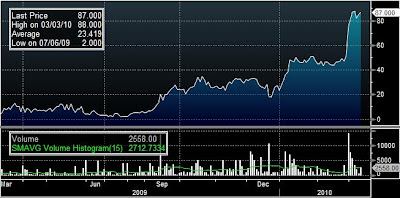Distressed Debt Equity Example - Visteon (VSTNQ)
In the past, I have pointed readers to the concept of understanding incentives in a distressed debt analysis when it comes to evaluating disclosure statement, plans of reorganization, and financial projections. In my opinion, management teams will side with the creditor class in which they will benefit most financially. I do not mean to admonish management teams for this action - they are acting in their own best self-interest (read: incentives) which, as I have reiterated in the past, is one of the keys to understanding how a certain bankruptcy case will unfold.
"Based on the valuation analysis prepared by the Debtors and their advisors (the "Valuation Analysis") and the Term Loan Lenders' secured position in the debtors' capital and corporate structure, the Plan contemplates that the Term Loan Lenders wil receive a 100% recovery on their Claims, which equates to an approximate 96.2% implied equity ownership interest in Reorganized Visteon and that the PBGC wil receive a 12% recovery on its Claims, which equates to an approximate 3.8% implied equity ownership interest in Reorganized Visteon."
The Valuation Analysis is dated as of December 15, 2009 and is based on data and information as of that date.
In preparing the Valuation Analysis, Rothschild has, among other thngs: (1) reviewed certain recent available financial results of the debtors; (2) reviewed certain internal financial and operating data of the debtors, including the business projections prepared and provided by the Debtors' management to Rothschild on December 15, 2009 relating to their businesses and their prospects; (3) discussed with certain senior executives the current operations and prospects of the debtors; (4) reviewed certain operating and financial forecasts prepared by the debtors, including the Financial Projections; (5) discussed with certain senior executives of the debtors key assumptions related to the Financial Projections; (6) prepared discounted cash flow analyses based on the Financial Projections, utilizing varous discount rates; (7) considered the market value of certain publicly-traded companies in businesses reasonably comparable to the operating business of the debtors; (8) considered the value assigned to certain precedent change-in-control transactions for businesses similar to the debtors; (9) conducted such other analyses as Rothschild deemed necessary and/or appropriate under the circumstances; and (10) considered a range of potential risk factors.Rothschild assumed, without independent verification, the accuracy, completeness, and fairness of all of the financial and other information available to it from public sources or as provided to Rothschild by the Debtors or their representatives. Rothschild also assumed that the Financial Projections have been reasonably prepared on a basis reflecting the debtors' best estimates and good faith judgment as to future operating and financial performance. To the extent the valuation is dependent upon the Reorganized debtors' achievement of the Financial Projections, the Valuation Analysis must be considered speculative...
Rothschild estimates the Reorganized debtors' implied reorganized common equity value to be $1.505 bilion based on the midpoint of the DEV range. The common equity value is subject to dilution as a result of the implementation of the Management and Director Equity Incentive Plans.
Certain of the Debtors' management and directors wil be entitled to participate in theManagement and Director Equity Incentive Program, which shall be set forth in the Plan Supplement. The Management and Director Equity Incentive Program shall have an aggregate share reserve of up to 10% of New Visteon Common Stock issued in accordance with the Plan, on a fully diluted basis. The Management and Director Equity Incentive Program shall be deemed approved and authorized without further action by the New Board.
Chapter 11 Plan of ReorganizationThe Plan, as filed with the Court on December 17, 2009, contemplates that the Debtors may pursue the termination of certain of the Debtors' pension plans. The Plan provides for the Pension Benefit Guaranty Corporation ("PBGC") to receive a 4% equity interest in the Company upon emergence from the Chapter 11 Proceedings in exchange for any termination- related claims it may have against the Debtors and their "controlled group members." As of December 2009, the Company estimated that this claim could total approximately $460 million.
- Sales came in at $6.69B vs 2009 plan projections of $6.45B
- Adjusted EBITDA of $454M vs plan projections of $302M
"Our restructuring, ongoing cost-reduction initiatives and ability to keep overhead costs aligned with reduced sales helped drive significant year-over-year improvements in cash flow and earnings, despite significantly lower vehicle production volumes and challenging industry conditions," said Visteon Chairman and CEO Donald J. Stebbins.
- Management on board - how to incentive them? With a big check.
- A valuation assessment where your class consequently becomes the fulcrum security ... i.e. low enough that no one behind you gets equity, but large enough to be plausible.





9 comments:
I do not totally follow the logic here. Why is it in mgmt's interest to report big year-end numbers before the plan is confirmed? From the way you lay it out, it seems like they would want to keep sandbagging until they confirm a plan, so they get the equity at a low valuation, and then report big results after they emerge once they can sell their stock. What am I missing here?
This is more about recutting the deal off of better numbers. Other BK case in auto parts sector seeing same thing, including recently with Accuride and now subs in Cooper
They can't sandbag the actual numbers - they are audited. They can sandbag projections and create a lower valuation...
Looks just like GSIGQ...
Hunter,
Many kudos for a great site and the remarkable energy you put into it. I follow the analysis with interest and it is ex post but very valuable. The investor goal is to try to find these opportunities beforehand. I am not an industry professional and I was wondering if you can do a post about finding primary sources such as the plan of re-organization and related documents as well as a timetable to important events in the bankruptcy process. Whenever I try to do this, I get lost in a minefield of documents and pages. Can you give us the benefit of your experience in trying to intelligently find and deal with documents and what sections we should emphasize? I realize this is asking a lot but it would be of great practical help. Forgive me if you've already done this.
The big question for me, as a bankruptcy lawyer and not yet an investor, is how do I get access to quotes so that I can analyze distressed opportunities? It seems like to make a contribution to DDIC you have to already be tied into the distressed pipeline. The value of using the site as a launchpad to a distressed investing interview or career is reduced if you don't have a bloomberg. Anyone know of other resources I can use?
so i gess the bottom line here is that we all mite in for a big fall of the stocks????/ or do we hold on to them ????
I'd have to second Jack's comment. Perhaps a step-by-step explanation of a simplified hypothetical BK and the major documents (and sources of the documents) and timing, and what to look for in each etc. would really help crystalize where to begin when looking at one of these. Thanks for all the work that you do. Incredibly informative.
After reading your analysis here, about 98% of which is over my head, I'm very curious if you've looked at the DISH/TSTRQ proceedings going on right now.
Some are hoping to ride a speculative wave on the TSTRQ share price on the strength of either a) commons coming out intact, or b) just the speculation that they might in tandem with some speculation about the assets TSTRQ has left over after the sale to DISH, i.e. what they might look like upon re-emerging.
All of this is so far beyond me, but I have considered playing TSTRQ for a pop. I'm curious about your thoughts.
Absolutely fantastic blog.
Post a Comment